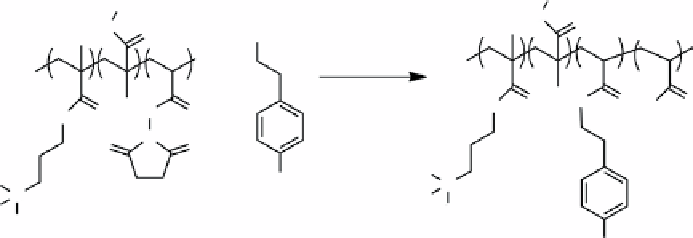Chemistry Reference
In-Depth Information
mPEG
mPEG
O
O
O
O
NH
2
i) DMF/THF, RT
ii) H
2
O
l
mx
n-x
l
mn
O
HN
O
O
O
HO
OO
O
O
N
O
O
HO
HO
OH
H
3
CO
H
3
CO
Si
Si
OH
l:m:n=1: 1.2: 1.8
OCH
3
OH
ScheMe 16.13
Tyramine conjugation to the TMSMSA-PEGMA-NAS polymer. Adapted from Ref. [94].
124
I
O
O
[
124
ICI]
OH
S
+ Na
124
I
N
-
Cl
Tyramine-polymer
124
I
Na+
Iodobead
HN
Polymer
O
ScheMe 16.14
Iodination of the tyramine-conjugated polymer using IodoBeads.
Iodinated SPIONs were designed to utilise Cerenkov radiation in a trimodal imaging system [94]. Cerenkov radiation is
a decay phenomenon in which optical photons are emitted when a charged particle moves faster than the speed of light in a
particular medium [95]. Therefore, no external light source is needed to stimulate Cerenkov light emission, which is contin-
uous. The intensity is dependent on the frequency and kinetic energy of the emitted particle. PET nuclides can be used with
the requirement of the positron energy be >262 eV for aqueous media.
To generate the iodinated nanoparticles, SPIONs were coated with poly(TMSMSA-rPEGMA-rNAS), which was synthe-
sised by combining 3-(trimethoxysilyl)propyl methacrylate (TMSMA), poly(ethylene glycol)methyl ether methacrylate
(PEGMA), and N -acryloxysuccinimide (NAS) with 2,2′-azo-bisisobutyronitrile, a radical polymerisation initiator [94].
Tyramine was added to the purified polymer, where the amine group reacts with the succinimide of NAS (Scheme 16.13).
Hydrolysis results in -Si(OH)
3
groups and free carboxylic acids. SPIONS were coated with the polymer and heated to form
cross-linking bonds between the Si(OH)
3
groups and carboxylic acids of the polymer on the particle surface.
IodoBeads (Pierce) were used to iodinate the tyramine on the particles. The IodoBeads convert sodium iodide to iodo-
monochloride (ICl), which readily incorporates iodine into tyrosyl groups next to the OH group on the phenolic ring
(Scheme 16.14).
124
I was used because of its long half-life of four days and high energy positrons (819 keV). The authors
found that Cerenkov imaging using
124
I has a resolution of 1.6-1.2 mm, while the PET resolution was limited to 2.4 mm. All
three modalities, optical, PET, and MRI, showed that the SLNs near the tumour showed lower uptake due to metastasis of
the tumour and subsequent destruction of the lymph nodes (Figure 16.31).
For a SPECT/MRI system, PEG-functionalised SPIONs were modified with
99m
Tc for bimodal imaging of sentinel lymph
nodes [96].
99m
TcO
4
-
was reduced using SnCl
2
in the presence of the SPIONs. Magnetic separation of the labelled SPIONs
from the solution showed no free
99m
Tc was present.
99m
Tc-SPIONs were detected in SLN by SPECT as well as MRI. Digital
autoradiography showed the uptake by the SLN was not homogeneous, and the authors suggest that the particles were
phagocytosed in the sub-central, central, and medullary sinuses.
16.7
ultraSound
Microbubbles (MBs), a term loosely applied to microstructures with an internal cavity, have been widely implemented as
ultrasound contrast agents [97-99]. The efficiency of MBs is dependent on the compressibility and density of the MB and
the gas or liquid within it. The difference in these factors between the MB and the surrounding medium allows contrast to
be observed. MBs have been made of lipids and polymers, and gases such as perfluorocarbons [100] and sulfurhexafluoride
[101] have been used [100, 101]. The walls of polymeric MBs have the disadvantage of being thicker than lipid-based MBs,


